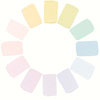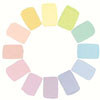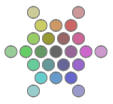 |
 |
|
|
Custom Color Ring
The pure color ring is fine for understanding the origins of colors and their relationships to one another, but inadequate for choosing colors for your home. Color rings that portray the colors in values and intensities you can live with and enjoy are much more useful. |
| The color rings below show the 12 colors in a range of four values - light, medium-light, medium and dark. All of the colors are less intense than the hues on the pure color ring. In reality, you will probably combine colors that vary in value and intensity: that just happens when you collect different materials. But the rings can help you become aware of the kinds of colors you prefer. Take a look. |
 |
Color Ring #1 Light-value, Low-intensity Colors: These are the colors we normally associate with the word "tint." They are light in value and low in intensity. Light, subdued colors, such as celery, chamois and fawn, are often chosen for walls. |
 |
Color Ring #2 Medium-light-value, Low-intensity Colors: These are still low in intensity but slightly darker in value than those in Ring #1. Use them when you want quiet color with a little more body, for walls, floors or furnishings. |
 |
Color Ring #3 Medium-value, Low-intensity Colors: These colors are versatile and easy on the eye. They are medium in value - midway between light and dark - and low in intensity. Subdued colors of medium value, such as dusty rose and lichen, are often used for large upholstered furnishings because they are not visually abusive. |
 |
Color Ring #4 Dark-value, Low-intensity Colors: Dark, subdued colors, such as burgundy and hunter green, add depth to a scheme. They combine naturally with rich woods, especially in rooms used at night - a dining room, perhaps, or a library. |
|
|||

